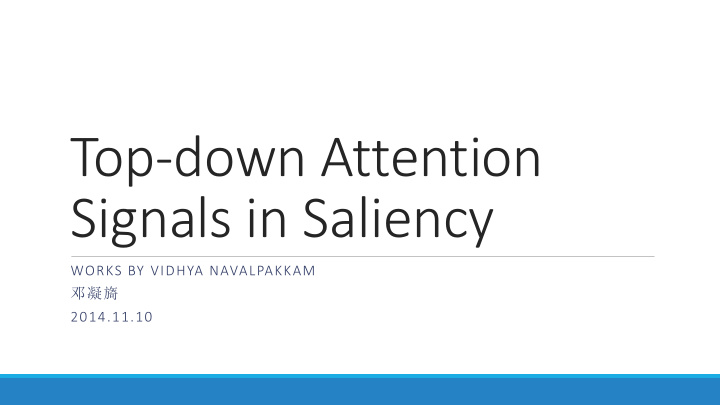



Top-down Attention Signals in Saliency WORKS BY VIDHYA NAVALPAKKAM 邓凝旖 2014.11.10
Introduction of Vidhya Navalpakkam EDUCATION * Ph.D, Computer Science, Fall 2006, University of Southern California (USC), Los Angeles, CA; Advisor: Dr. Laurent Itti * B.Tech, Computer Science, Fall 2001, Indian Institute of Technology (IIT), Kharagpur, India EXPERIENCE * Google, Research Scientist, May 2012-present * Yahoo! Research, Research Scientist, Jul 2010-May 2012 * Caltech, Biology, Postdoctoral Research Scholar, Jan 2007-Jul 2010; Advisors: Dr. Pietro Perona, Dr. Christof Koch * Stanford CS, Visiting Postdoctoral Scholar, Aug 2009-Jul 2010; Host: Dr. Fei-Fei Li
Top-down Attention Selection is Fine Grained VIDHYA NAVALPAKKAM & LAURENT ITTI JOURNAL OF VISION 2006
Importance of top-down signals In natural world, when predators are camouflaged and, hence, visually nonsalient, the prey’s survival depends on whether top -down can guide attention by selecting the fine-grained target feature
An Integrated Model of Top-down and Bottom-up Attention for Optimizing Detection Speed VIDHYA NAVALPAKKAM & LAURENT ITTI CVPR2006
Background Use attention to accelerate detection speed Need to integrate top-down and bottom-up attentional influences Need to consider knowledge of the target and distracting background
Goal Get the saliency map of target
Approach Propose a new model that combines both bottom-up as well as top-down attentional influences The model first computes the naive, bottom-up salience of every scene location for different local visual features (e.g., different colors, orientations and intensities) at multiple spatial scales Next, the top-down component uses learnt statistical knowledge of the local features of the target and distracting clutter, to optimize the relative weights of the bottom-up maps such that the overall salience of the target is maximized relative to the surrounding clutter Such optimization renders the target more salient than the distractors, thereby maximizing target detection speed
Bottom-up Saliency Map
Saliency model by Itti L. Itti, C. Koch, and E. Niebur. A model of saliency-based visual attention for rapid scene analysis. PAMI 1998.
Differences between feature pyramid Normalization Gauss Convolution
Top-down Gains
Relevant objective function to be optimized SNR ◦ Detection speed depends on the ratio between the strength of signal detecting the target(i.e., target salience), over that detecting the distracting background (i.e., distractor salience) ◦ The relevant goal for maximizing object detection speed is to maximize signal- to-noise ratio SNR ◦ ST(A)be a function of the input search arrayA, which is a function of the visual features of the target Θ|T(sampled from probability density functions P(Θ|T )). A is also a function of the relative locations or spatial configuration of the target and distractors (C). Since C and Θ|T are random variables, so is ST(A). ST(A)is also influenced by noise in neural response , η. And the same for the salience of the distractors, SD(A)
Relevant objective function to be optimized SNR: the ratio of expected salience of the target over distractors Salience within a dimension Salience across dimensions
The expected salience of the target and distractors
Learning top-down gains
Maximizing SNR to obtain the optimal gains
Maximizing SNR to obtain the optimal gains
Resault
T0D0 , the naive, bottom-up model does not know T or D (hence, uses default top-down weights of 1) T1D0 combines bottom-up salience with knowledge of T only. Hence, it computes top-down weights based only on target salience sijT, while ignoring D by considering sijD to be some constant. T0D1 combines bottom-up salience with knowledge of D only T1D1 combines bottom-up salience and top-down knowledge of both T and D.
Training and test data For each search condition with the synthetic stimuli, the model learn target belief in salience (SbT, SbD) from 50 training images, computes the mean salience of the target and distractors In each of the 100 test image images, the target and distractors can occur randomly at any cell within the 9x9 grid, and their location within the cells is further jittered by upto 10 pixels (thereby changing C). Noise in stimulus features is also added, in the form of jitter in orientation (upto 5 ◦ ), and jitter in color values (upto 20 in R,G and B), thereby changing Θ|T,Θ|D. Internal neural noise η is added by the saliency model.
Training and test data
Recommend
More recommend